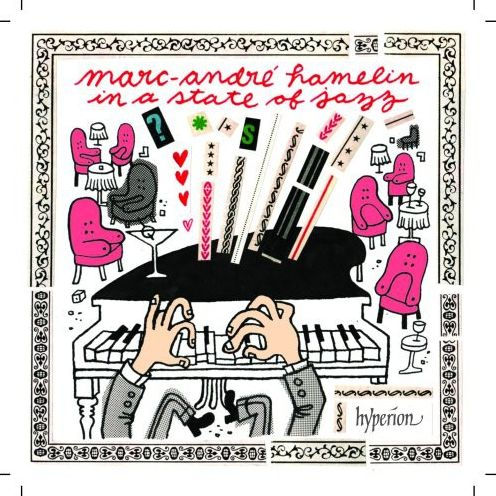Marc-Andre Hamelin's
Hyperion disc
In a State of Jazz is not an example of a classical pianist letting his hair down, nor attempting to fuse jazz with classical music, or to create something a tad more commercial than, say, an album of
Tausig transcriptions. This collection features works by four classical pianist-composers --
Friedrich Gulda,
Nikolai Kasputin,
Alexis Weissenberg, and
George Antheil -- who fashioned piano music "in a state of jazz," though in fully notated form. The one exception to the rule is
Alexis Weissenberg's Six arrangements of songs sung by
Charles Trenet, which first appeared on a 45 rpm record in the 1950s credited to "Mr. Nobody." This was
Weissenberg, who was attempting to protect his career as a classical piano virtuoso through hiding under this made-up name; he did not write down these arrangements, and
Hamelin has transcribed them from the record himself.
Weissenberg's impulses were correct; had he released his jazz music under his own name it very well could have wrecked his career; Viennese composer
Friedrich Gulda made major strides towards breaking down such barriers, and his work is represented through three exercises from his pedagogical collection
Play Piano Play (1971) and
A Prelude and Fugue (1965).
Nikolai Kasputin is a name unknown in the West until the turn of the 21st century, and this in itself is none too surprising, as
Kasputin has stated that he "does not want to become famous." A one-time student of Moscow Conservatory pedagogue
Alexander Goldenweiser, since the late '50s,
Kasputin has been turning out an impressive portfolio of jazz-inspired compositions, including six piano concertos, a fantasy of piano and orchestra, and numerous solo sonatas and preludes.
Kasputin does not like to improvise and disdains live performances -- both pre-requisites in conducting a career as a jazz pianist -- so his solution was simply to write everything out. His works were published one after another even in the Soviet period, and
Kasputin claims that he has made a good living from it -- the emergence of interest in his work outside Russia is something that seems a little befuddling to him.
Hamelin -- and
Steven Osborne, who first recorded
Kasputin's music for
Hyperion -- has served as an ardent champion for
Kasputin's music in the West, and here interprets
Kasputin's
"Piano Sonata No. 2," a work which, for
Hamelin, "became an obsession."
The Jazz Sonata (1922-1923) of
George Antheil is a work that is short even for a composer who produced dozens of short piano works -- it lasts only 90 seconds. Nevertheless, its dense and bumpy trajectory properly reflects the influence of early jazz on composers of the earlier generation of the '20s, and certainly belongs here.
Hamelin's playing is zippy and enthusiastic in fast movements and deeply felt in slower ones; with
Hamelin, technical considerations of playing are generally irrelevant, what matters is expression and pacing. There is no tradition in such music of a need to swing the rhythm, though one wonders if a little added sense of flexibility might not have served him here.
Hamelin is so forthright in fast movements that it is a little difficult to take it all in -- repeat listening is encouraged. Apart from that admittedly minor reservation, this is a terrific disc from start to finish;
Hamelin's pianism is dazzling as usual, and the program of works are all impressive entries into this "Third Stream" genre, taken from the more classical side of the tracks than from jazz. The
Weissenberg transcriptions from
Charles Trenet are a particular highlight. ~ Uncle Dave Lewis






